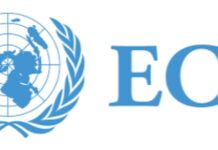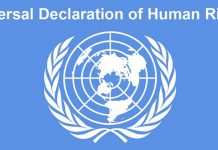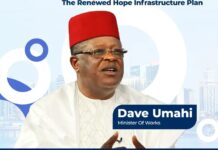Suspected fighters are paraded before Burundian media near a cache of recovered weapons. Bujumbura, Burundi, December 12, 2015. (Jean Pierre Harerimana/ Reuters/ Corbis).
The African union Peace and security Council (PSC) broke new ground yesterday by adopting a communiqué that threatened to a launch a 5,000 strong force to protect civilians in Burundi. The communiqué gave the Burundian government 96 hours to consent to the operation of face the scenario of the AU deploying the force anyway. Although Burundi was a member of the PSC – and was actually its designated chair for December 2015 – the council utilized Article 8(9) of the Protocol Relating to the Establishment of the PSC (2002) to ask the Burundian delegation to remove themselves from the chamber during the substantive deliberations on this issue.
If the Burundian government consents to its deployment, the force, dubbed the African Prevention and protection Mission in Burundi (MAPROBU), will still confront many practical challenges, not least how to stabilize the country and help facilitate a political settlement of the crisis there, which is thought to have killed hundreds of people, mainly civilians, in the past few months, However, if the Burundian government calls the AU’s bluff and refuses to invite MAPROBU onto its territory, this raises an even more fundamental set of challenges for the AU. Whatever happens, this communiqué is a novel form or coercive diplomacy exercised by the AU that raises many important questions for African governments, regional organizations, the United Nations, and other stakeholders in Burundi’s ongoing crisis, not least the country’s citizens. This report briefly discusses five of those questions.
{Ed. Note: On December 21st, Burundi’s parliament unanimously rejected the proposed AU force. Two days later, Burundi’s foreign minister wrote a letter to the Chairperson of the AU Commission, in which he accused Rwanda of stoking rebellion in Burundi and rejected MAPROBU as tantamount to an invasion force.}
Under What Authority Will MAPROBU Deploy, and Would It Be Legal?
First of all, under what authority can the AU launch MAPROBU and would it conform to existing international law? Because the mission’s mandate (see below) envisages the potential use of force beyond self-defense and in defense of the mission’s mandate, even if the Burundian government consents to its deployment it would also require a Security Council resolution under Chapter 7 of the UN Charter. The major controversy, however, would arise if the Burundian government does not consent to MAPROBU’S deployment. In that case, Article 4(h) of the AU’s Constitutive Act claims “the right of the Union to intervene in a member State pursuant to a decision of the Assembly in respect of grave circumstances, namely: war crimes, genocide and crimes against humanity.” The PSC’s invocation of Article 4(h) would seem to imply that one of these crimes was occurring in Burundi or was imminent, and hence the emphasis of the mission was to prevent further escalation. Given considerable skepticism about genocide and the current lack of civil war conditions in the country, it seems reasonable that crimes against humanity were the main immediate concern for the PSC, along with a desire to prevent escalation. But the PSC’s communiqué made no explicit determination, which raises the question of what data and analysis was presented to the PSC to trigger the use of Article 4(h) language. Presumably, the principal sources of on-the-ground information available to the PSC were the African Commission on Human and Peoples’ Rights’ fact-finding mission, which visited Burundi from December 7-13, and the
AU’s own human rights observers deployed in Bujumbura. Under the communiqué, the AU has not yet authorized an Article 4 (h) intervention. Rather, it has threatened one.
Consequently, this currently represents a case of coercive diplomacy rather than a decision to launch what the academic literature usually refers to as “humanitarian military intervention,” defines as the use of military force by external actors without host state consent aimed at preventing or ending genocide and mass atrocities. If the AU subsequently decided to launch MAPROBU without the consent of the Burundian government, this would constitute a humanitarian military intervention. There is considerable debate in international law as to whether such interventions are legal. Although Article 4(h) of the AU Constitutive Act would seem to imply that the AU Assembly could legally authorize the use of military force for human protection purpose without the host government’s consent, this stands in direct contradiction of Article 53 of the UN Charter. Similarly, the majority of legal experts seem to concluded that under existing international law, the use of military force against a sovereign state is permissible in only two circumstances: for the purposes of self-defense, or with the explicit authorization of the UN Security Council. Neither of these circumstances applied when the PSC took this decision. In paragraph 15 of the communiqué, the PSC requested “the UN Security Council to adopt, under Chapter VII of the Charter of the United Nations, a resolution in support of the present communiqué”. It remains to be seen if the UN Security Council would respond favorably to the AU’s request, especially if the Burundian government did not give its consent for MAPROBU’s deployment. The most important potential precedent for such an action was UN Security Council resolution 1973, authorized in March 2011 to protect civilians in Libya. Perhaps in recognition of this problem, since 2005 the AU has explicitly acknowledged that it needs to seek UN Security Council authorization for any use of military force beyond self-defense, including that authorized under Article 4(h). In the AU’s Roadmap for the Operationalization of the African Standby force, it is explicitly stated that “the AU will seek UN Security Council authorization of its enforcements actions. Similarly, the RECs {Regional Economic Council}/Regions will seek AU authorization of their interventions.” Instead, the PSC’s communiqué has taken the lead by threatening to use force against the Burundian government’s wishes before securing similar agreement from the UN Security Council. What should be the Composition of MAPROBU? A fourth important question revolves around the composition of any potential prevention and protection force. It is important to think about this question even if the AU does not end up deploying an operation- the PSC communiqué leaves open the issue of what would happen should the Burundian government refuse to consent to the AU Assembly. MAPROB’s composition is important regardless of whether the Burundian security forces would welcome, be neutral towards, or be actively hostile to any AU force. It seems very unwise to try and deploy a force of 5,000 troops, police, and civilians if they would be treated as hostile, invading forces by the much larger numbers of Burundian soldiers and police. On the other hand, if the AU’s threat of coercion succeeds and the Burundian government consented to MAPROBU’s deployment, it is still important to ask which African countries can and should contribute to such a force. In several previous cases, AU peace operations have drawn their contributors principally from states local to the sub-region and even from neighbors of the host country. The most recent examples of this trend are the African-led missions in Somalia (since 2011), in Mali, Central African Republic, as well as the two AU-authorized multinational coalitions against the Lord’s Resistance Army in central Africa and Boko Haram in West Africa. It is important to recall that in the case of Somalia, however, the Intergovernmental Authority on Development (in 2005) and the AU (in 2006-07) initially thought it prudent to prohibit “frontline state” from participating in their proposed peace operations (first IGASOM, which never deployed, and then AMISOM, which deployed to Mogadishu in 2007). This requirement was subsequently changed to allow neighboring countries to join AMISOM in 2011. In Burundi’s case, the AU has several options from which to generate a potential MAPROBU. One option, and the most likely option, is to utilize the Eastern Africa Standby Force (EASF). The EASF declared its full operational capability in December 2014 and has been debating contingency options for Burundi for several months. It does not, however, have a standby force such. That is there are not 5,000 troops, police, and civilian experts garrisoned together, trained, equipped and waiting for the order to deploy. Rather, the EASF has pledged from its 10 member states (Burundi, Comoros, Djibouti, Ethopia, Kenya, Rwanda Seychelles, Somalia, Sudan, and Uganda) that it would need to assemble to deploy for any specific operation. Importantly, the bulk of the pledged EASF personnel are made of one battalion of troops from each of Burundi, Ethiopia, Kenya, Rwanda and Uganda. Burundi has also pledged a formed police unit, some military observers and some civilian experts. So in this case, the AU would need to decide which parts of the EASF pledges it would want to use to form part or all of the MAPROBU. Assuming Burundian has troops and police would not participate in any EASF deployment in Burundi, this would leave a potential force of about 5,000 personnel (including troops, police and civilians). The EASF has yet to deploy its full force in a real operation, although several of its individual member states have considerable experience in peace operations. A second option is the African Capacity for Immediate Response to crises (ACIRC). The ACIRC was conceived after the failure of AU states to deploy a rapid intervention force to stop the crisis in Mali in late 2012 and early 2013. The theory behind ACIRC is that it will draw from a reservoir of 5,000 troops to field tactical battle groups of approximately 1,500 military personnel deployed by lead/framework state or a group of AU member states, and which would be self-sustainable for 30 days. Its stated purpose is to conduct stabilization and enforcement missions, neutralize terrorist groups and provide emergency assistance to AU member states. However, the ACIRC was designed as a purely military capacity without police or civilian elements. This may make it less well-suited to carrying out the mandate provided in the PSC communiqué (see below). The ACIRC has also yet to deploy in real operation. A third option would be for AU to assemble a coalition of the willing from among its member states to build a MAPROBU force comprising troops, police, and civilian experts. Usually, such coalitions work best if they form around a lead/ framework state and comprise relatively few contributing countries. This would give the AU the most flexibility to determine MAPROBU’s contributors. It would also focus attention on which state might represent the most sensible choice to lead such an operation. This will likely be the subject of considerable debate and it is not my intention to resolve it here. Suffice to say that any lead/framework state and coalition members would need to be chosen carefully and must possess both the relevant capabilities to carry out such a mission and the right political credentials to do so impartially. Should MAPROBU Be Deployed? This leads to the fifth crucial question discussed here: whether the deployment of such a force would be prudent? It appears that the main drivers behind this communiqué were the reports of escalating violence that the AU was receiving from the field – the AU human right observers in Bujumbura and the returning fact-finding mission of the African Commission on Human and Peoples’ Rights-and anxiety that the existing mediation plan was failing to produce the desired progress. Moreover, Burundi’s government has a responsibility to protect its citizens, and there is clearly a moral and political imperative to consider whether the treat or deployment of external forces could play a constructive role in managing the country’s political crisis. According to Cedric de Coning of the Norwegian Institute of International Affairs, the AU was faced with the difficult questions of what more could be done to stem the violence and whether diplomatic pressure alone would work. The communiqué suggests the PSC decided that the time had come to authorize a mission focused on preventing further escalation of Burundi’s crisis. For de Coning this in itself might provide additional political leverage to change the behavior of Burundi’s government, or, failing that, at least increase the level of stability in the country to make further political progress related to the national dialogue. However, if the Burundian government and its security forces were to treat the MAPROBU as a hostile invasion then, in my opinion, to even attempt its deployment in its currently proposed form would be unwise. But what if the Burundian government consented to MAPROBU’s deployment? In this case the mission should deploy, but it would face several obvious challenges (in addition to the need for a UN Security Council resolution noted above). First, it is clear that any military force would be a very blunt instrument for addressing the political problems that lie at the heart of Burundi’s crisis. The deployment of peacekeepers alone cannot resolve political crises; that requires effective conflict resolution and reconciliation. However, if used as part of a broader political strategy they might be able to help stabilize the situation so that political progress can be made. Second, much would hinge on the mission being able to carry out a realistic and appropriate mandate. The communiqué set out MAPROBU’s mandate as follows: “…to : (a) prevent any deterioration of the security situation, monitor its evolution and report developments on the ground; (b) contribute, within its capacity and in its areas of deployment, to the protection of civilian populations under imminent threat; (c) to the creation of the necessary conditions for the successful holding of the inter-Burundian dialogue and to the preservation of gains made through the Arusha Agreement for peace and Reconciliation in Burundi; (d) facilitate, in collaboration, as appropriate, with other international actors, the implementation of any agreement the Burundian parties would reach, including, but not limited to, the disarmament of militias and other illegal groups the protection of political personalities and other actors whose security would be threatened; and (e)protect AU personnel, assets and installation” (para. 13.a.ii).|” mandates for peace operations that involve civilian protection are never simple, and the communiqué’s decision to limit the mandate to “the protection of civilian populations under imminent {emphasis added} threat” means that most situations that fall under this category will already be too late for peacekeepers to stop violence. This is why the UN Security Council has recently started removing the word “imminent” from its civilian protection mandates, as occurred in the UN Mission in South Sudan in May 2014. Moreover, all civilian protection mandates are likely to encourage a large gap between local and international expectations and the capabilities of the peacekeepers. Such an expectations- capabilities gap will make it very difficult for the external force to operate effectively on the ground. These issues would also raise questions about the appropriate force configuration and deployment “footprint,” i.e where should such forces deploy within Burundi and how should they be dispersed?
A third challenge relates to the contested nature of consent in these typesof circumstances. In 2005, the Burundian government asked a peacekeeping operation (ONUB) authorized under Chapter7 of the UN Charter t and its head to leave the country early. Since then the government has also declared various UN personnel person persona non grata. What would be the contingency plan if this happened again? Similarly, the Burundian government could do what the Sudanese government did in 2006, when Khartoum consented to the deployment of UN peacekeeping operation (UNAMID) with Chapter 7 powers, but then did everything it could to make life difficult for that mission. What would be the AU’s contingency plan in such circumstances? Finally, in 2008, the Eritrean government asked a UN peacekeeping operation (UNMEE) to leave its territory because it felt the mission was helping to maintain the non-implementation of the Algiers Agreement, signed in 2000. Is there a risk that a peace operation deployed in Burundi help consolidate the non-implementation of the Arusha Accords (the peace agreement signed in 2000 that was widely attributed with having brought Burundi out of its 1993-2005 civil war)?
***** ***** ***** ***** ***** ***** ***** ***** ***** ***** ***** *****
The latest communiqué from PSC on the situation in Burundi represents a novel form of coercive diplomacy for the African Union. Outsiders clearly have a variety of reason s why they should try and find a settlement to Burundi’s ongoing political crisis. But they should be under no illusion that there is a quick or simple military fit to this inherently political crisis. Any solution will require concerted and sustained political leadership from inside and outside the region. But it remains to be seen whether the AU’s coercive diplomacy can play a constructive role in reducing the number of the civilian victims of Burundi’s crisis and help bring about resolution. For the AU, it has now taken on a novel set of challenges in this area and it must now work hard to overcome them.
































